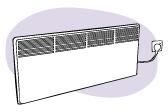
Wall-mounted electric panel heaters are reasonably cheap to run, and are fairly safe to use due to the convective heat they give off.
Wall panel electric heaters, or electric panel heaters use electricity to slowly heat a large surface (typically stainless steel or ceramic). They can either be portable or permanent fixtures, attached to a wall or even a ceiling. Electric wall panel heaters are suitable for use in smaller areas, but are considered fairly inefficient for central heating purposes.

How energy efficient are electric panel heaters?
Electric radiant panel heaters use less power and give out a less intense heat than some other portable electric heaters (like radiant bar heaters or convection fan heaters). As such they’re considered to be reasonably energy efficient as far as electric heaters go, using around 1/3 as much electricity as their radiant bar heating cousins. They are a little slower to heat up than some other electric heaters though, so aren’t necessarily as appropriate in places where heat is needed quickly and for relatively short amounts of time.
Installation requirements
There aren’t many restrictions on where electric panel heaters can be installed or placed – in fact, the most you really need is a power point to plug them into, and perhaps some mounting brackets.
That being said, as these types of heaters are often installed in bathrooms, you need to ensure that you comply with the Building Code’s minimum clearance distances from water supplies (or further, if specified by the manufacturer). This is typically a separation of 60cm, but check with your local regulator for confirmation.
Where do I put it?
As wall panel electric heaters are lightweight and provide a very localised kind of heat, they are typically used in smaller areas, such as bathrooms. Because they are much more economical to run over the longer term than many other types of electric heaters, they are also ideal as clean, efficient space heaters in bedrooms, offices and studies.
|
Advantages
|
Disadvantages
|





